Vernix caseosa is a naturally occurring substance which covers the skin of foetus in last trimester of pregnancy [1,2]. It is mainly composed of water (80.5%), lipids (10.3%), and proteins (9.1%) [3]. which owes to the mixture formed by the shed periderm layer of the epithelium with the sebum secretions from the sebaceous glands [4,5]. Vernix also has lysozyme and lactoferrin as the other innate immune proteins. The broad-spectrum activity of these proteins and specially the cathelicidins and defensins, may also play role in avoiding the development of resistance in bacterial pathogens. The molecular markers EG2 and CD 1a are also present and they are protective [6]. pH decreases just after the birth of the foetus which is attributed to maturation of enzymes responsible for the synthesis of acidic components [7] and triglycerides in Vernix which could be a source of acidic fatty acids (provided conditions for hydrolysis are present) [8] . This makes the nature of stratum corneum acidic. This also prevents the growth of pathogenic bacteria on the skin [9–11]. Study by Visccher et al., suggests that this acidification process appears to occur earlier in the presence of Vernix retention [12]. There is one report which suggests that Vernix acts as mechanical barrier to bacterial invasion [13]. One study has refuted the role of Vernix having anti-microbial property [13]. This study was undertaken to know the properties of Vernix caseosa as there are many conflicting reports.
This study will help in better practices (like retaining the Vernix till it falls of itself as compared to present practice of wiping it just after birth) which may help in preventing neonatal infection.
This study was conducted with objectives of knowing if Vernix acts as mechanical barrier to bacterial invasion and also to know the phenotypic effect of its anti-bacterial property.
Materials and Methods
This study was conducted at Government Lady Goshen Hospital, Kasturba Medical College, Mangalore. The protocol was approved by, Institutional Research committee and the Institutional Ethics Committee.
Exclusion criteria: As normal bacterial flora of the vagina would be found on the skin and vernix of the babies born by vaginal route they were excluded from the study and it was decided to include babies born by caesarean section.
Vernix was collected from the skin of 63 babies as soon as they were delivered by caesarean section. Samples were transported to lab under aseptic condition.
Sample size- S.aureus and E.coli are common organisms responsible for Early onset neonatal sepsis [14,15]. Assuming that at least 86% of newborn will have colonization by Staphylococcus aureus [16] for 95% confidence interval and 90% power a sample size of 63 were calculated.
Subjects were selected by non-random sampling method with sequential inclusion of infants (not falling in exclusion criteria), till the sample size was reached.
Study Instruments
A semi-structured pro-forma was developed. Basic details like-Ante-natal care, Intra–natal care, Birth weight, Maturity of baby, distribution of Vernix was noted.
Sterile bottle with spatula (PW015), vaccine carrier, culture plates.
Specimen collection- Vernix was collected from all healthy infants using a sterile bottle with spatula (PW015) as soon as they were born and transported to the lab in a vaccine container maintained at 4oC.
Laboratory processing: In the lab Vernix was transferred to a sterile test tube. A loopful of this Vernix was cultured on chocolate agar to ascertain its sterility. Preparation of Vernix Broth- This was done by adding loopful of Vernix to 500μl of Tween 80. It was kept in incubator for 4-5 hours. Vernix was then spread with a sterile loop on to a filter paper of 1 cm2 to prepare filter papers impregnated with Vernix. Standard strains of S.aureus (ATCC 25923) and E.coli (ATCC 25922) were used to prepare the inoculum in nutrient broth and adjusted to 0.5 McFarland [17–19].
Testing Antibacterial property [Table/Fig-1] - The antibacterial property was tested by the following using the following method:
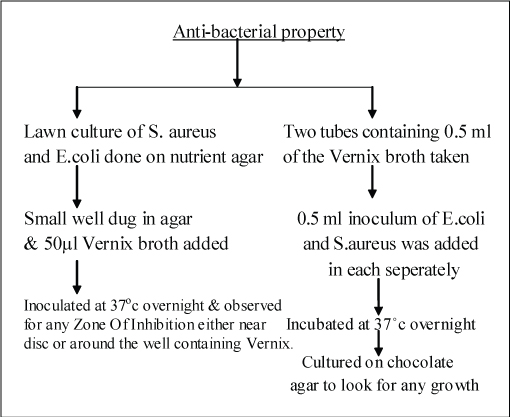
A lawn culture of S.aureus and E.coli was done on nutrient agar. Wells were prepared in the medium in which 100μl of Vernix broth was inoculated. Then it was incubated at 37°C overnight. Any zone of inhibition around the well was noted.
Two tubes containing 0.5 ml of the Vernix broth was taken. 0.5 ml of the inoculum of S.aureus to one tube and 0.5 ml of inoculum of E.coli was added to the other. This was incubated overnight at 370C and then cultured on Chocolate agar to observe if there was any growth.
Testing Mechanical Barrier Property [Table/Fig-2]- The Mechanical barrier property was tested using filter papers impregnated with Vernix. Each Filter paper was then inoculated with either S.aureus (50μl) or E.coli (50μl). Filter papers without the Vernix were used as controls.
Mechanical barrier property

Statistical Analysis
Data was entered in SPSS 12.0 version and analysed. Results were expressed as proportions spectrum of bacterial growth in appropriate table and graph. The zone of inhibition (in mm) in case of bacterial growth was expressed as mean with standard deviation. Student’s independent t-test was used to compare the means across the groups (Males and Females).
Results
All the vernix was found to be sterile. In all the samples, there was a zone of decreased bacterial growth around the well in which Vernix & Vernix broth was put [Table/Fig-3,4].
Area of DBG of S. aureus around the well containing vernix broth
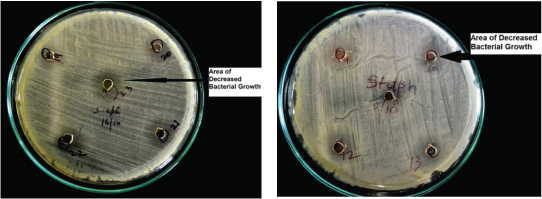
Area of DBG of E. coli around the well containing vernix broth
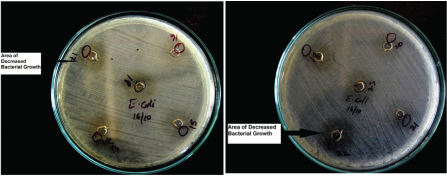
The mean diameters (Standard Deviation) of the zone of Decreased Bacterial Growth (DBG) are as follows-: S.aureus- 13.34mm (1.94); E.coli-18.06mm (1.56). The difference were statistically significant (p=0.000) [Table/Fig-5].
Area of Decreased bacterial Growth
| Organism | Decreased bacterial growthMean ± (SD) | Student independent “t” test(p-value) |
|---|
| E.coli | 18.06 mm (1.56) | -19.67 (0.00) |
| S.aureus | 13.34 mm (1.94) |
Even the culture on chocolate agar didn’t show any growth [Table/Fig-6,7]. This area of DBG lasted for 48 hours. The gender and birth weight of baby didn’t influence the antibacterial property [Table/Fig-8]. The result of mechanical barrier was inconclusive as there was no growth beneath either of the filter papers i.e. with Vernix impregnated or without it
Chocolate agar showing no growth of S. Aureus
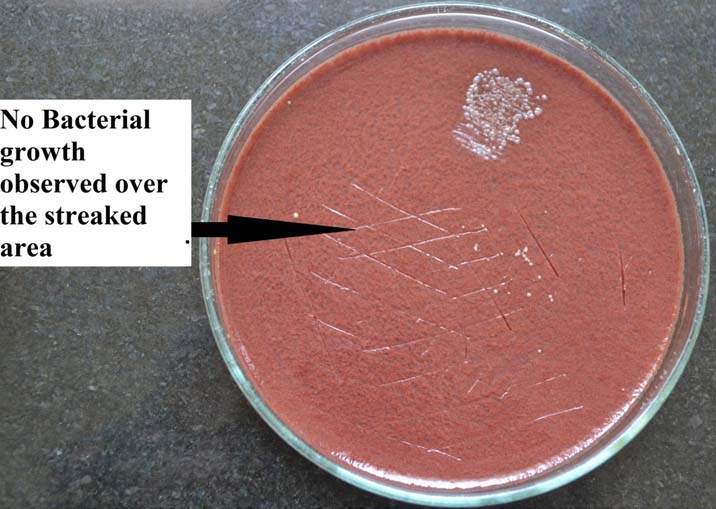
Chocolate agar showing no growth of S. Aureus
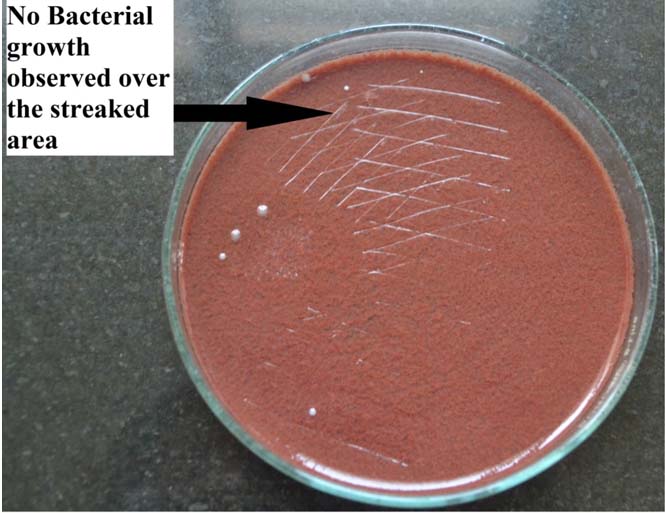
Influence of gender on anti bacterial property gender on
| S.aureusMean (SD) | Student independent “t”test (p-value) | E.coliMean (SD) | Student independent‘t’ test (p-value) |
|---|
| MalesFemales | 13.34 (0.97)13.13 (2.61) | 0.43 (0.67) | 17.94 (1.48)18.19 (1.66) | - 0.65 (0.52) |
| Birth weight-2.5-3 kgs>3kgs | 13.28 (2.07)13.00 (0.86) | 0.39 (0.69) | 18.15 (1.58)17.56 (1.42) | 1.05 (0.29) |
Discussion
Since ages there has been practice of wiping Vernix off the body of a newborn in order to make the baby look clean. But now queries have been raised against this practice as today many researchers have identified substances in the Vernix which may be responsible for the anti-microbial property [3,6] but none have proved it phenotypically.
Antibacterial Property : As vernix broth was prepared with Tween 80, there are two possible explanations for decreased bacterial growth: 1) Tween 80 had antibacterial property. But this is unlikely, as the well without Tween 80 also had decreased bacterial growth [Table/Fig-9] and when Tween 80 was used as a control bacterial growth could be seen around the well [Table/Fig-10,11]. Besides it has been shown that Tween 80 has no antibacterial property [20].
One of the specimen showing growth even without tween 80.
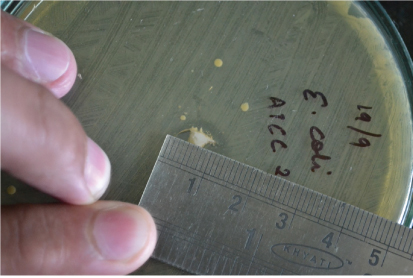
Growth of S. Aureus can be seen around the well containing tween 80
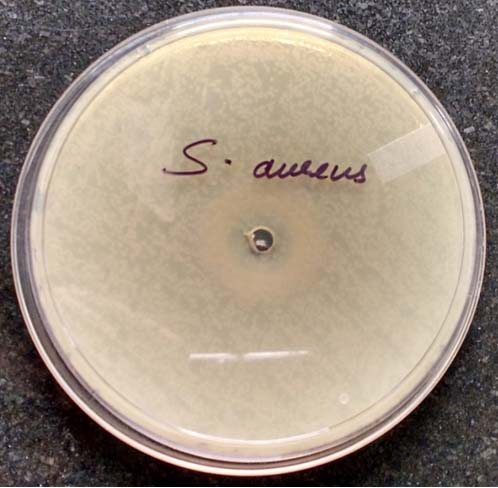
Growth of E. Coli can be seen around the well containing tween 80.
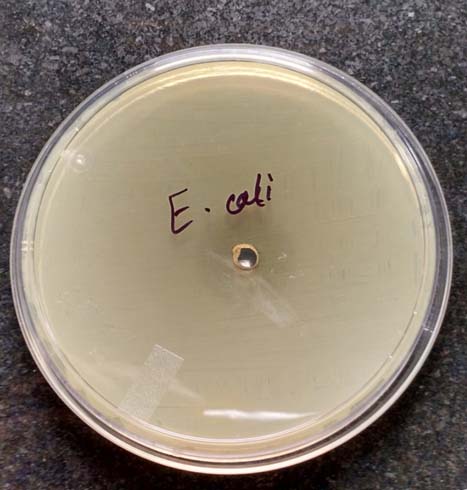
Vernix has antibacterial property which is likely. There are no other explanations for decreased bacterial growth. Also, in contrast to study done by Tollin et al., our study clearly indicate that the zone of DBG was more for gram negative bacteria than gram positive bacteria [16]. Interestingly for some hygienic reasons even WHO recommends retention of Vernix on the skin surface after birth [21].
Mechanical Barrier Property: As Filter paper impregnated with Vernix was placed on the agar and then a drop of S.aureus and E.coli inoculated on the Vernix, there could have been no space for the organism to percolate through the filter paper (which might have happened in the control). Reason for this is, when a filter paper is placed on the agar, it gets totally stuck leaving no space for any organism to percolate through it so that it can grow on the area of the agar covered by the filter paper. Thus, probably it was the filter paper that prevented the seepage of the organism. So our findings were inconclusive [Table/Fig-12,13 and 14]. There was a study done to prove the mechanical barrier property of Vernix but the methodology used was inappropriate as no control was used [13].
No growth of S.Aureus beneath the filter paper (lifted by forceps) impregnated with vermix
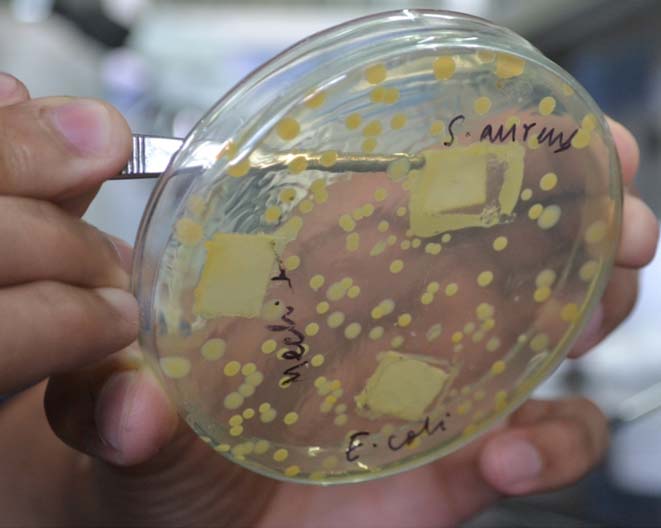
No growth of E.Coli beneath the filter paper (lifted by forceps) impregnated with vermix
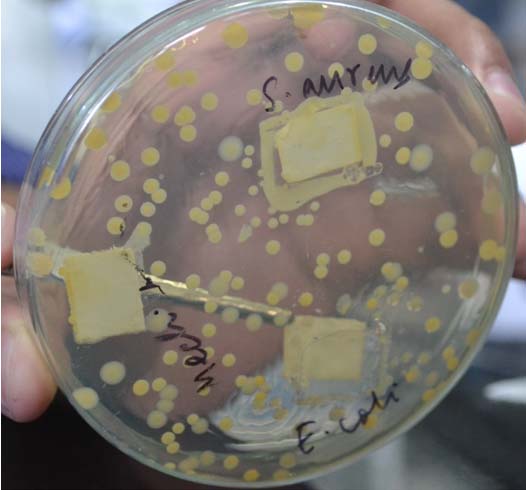
No growth of beneath the plain filter paper (lifted by forceps) impregnated with vermix
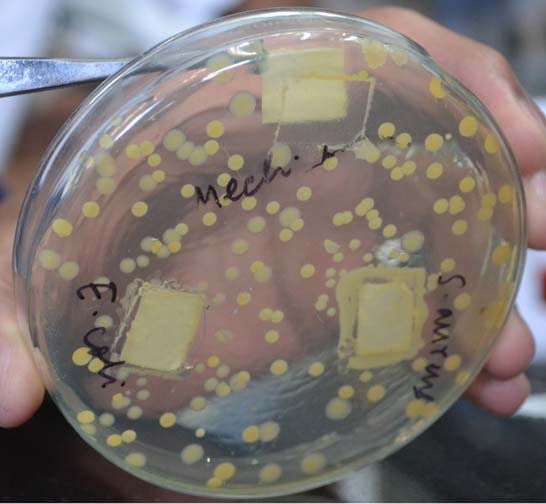
Limitation
We could not club this study with analysis of possible proteins, lipids or other substances that were responsible for the antibacterial effect. Also, the duration of anti-bacterial property was not studied as the culture samples were discarded after 48 hours. Testing for Mechanical barrier property should be done with filter paper put in the agar in such a way that it is vertically placed thus dividing the agar into two parts with one part smeared with the bacteria and then looked for growth over the other half.
Conclusion
Vernix caseosa has antibacterial property. Further studies with innovative techniques are needed to study the mechanical barrier properties.
The clinical and applied significance of our work are that presently the new born babies are wiped as soon as they are born. This removes Vernix which has antibacterial properties. The findings of this research imply that this practice needs to be changed. Also, Vernix caseosa could be used as a natural alternative for preparation of topical anti bacterial cream.